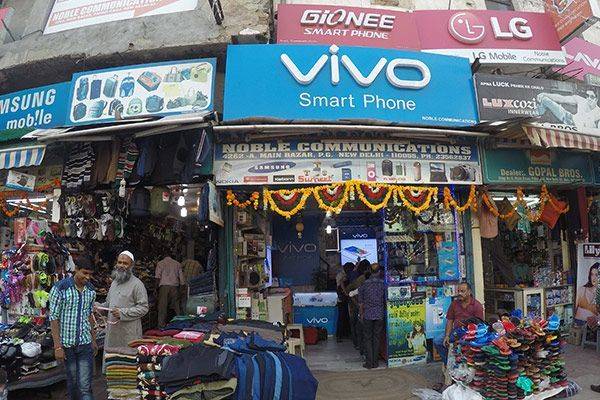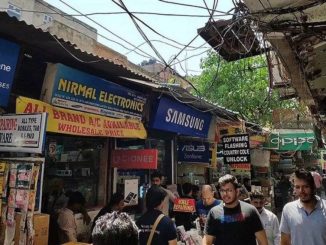What’s behind the success of Indian mobile phone brands? The answer is simple: the marketing channels of Indian mobile phone brands combining with supply chain in China.
“They don’t have the ecosystem of hardware, neither do they has software or internet advantages, but they’re very strong in developing local sales channels and branding”, said Bai Peng, with years of experience working for Huqain, the leading Chinese original design manufacturer producing for over 10 Indian mobile phone brands including Micromax, Karbann and Lava.
Who’s Gfive?
It’s no exaggeration to say Indian phone market was like a mirror, from which Chinese phone manufacturers were able to see their embarrassing position in global supply chain, without brands, R & D, chips and patents, what left were only advantages of supply chain, low prices, the audacity and insight from years of barbaric growth.
At that time in Indian market, Gfive was a completely different kind, founded by Zhang Wenxue, who started from manufacturing phone cases in Shenzhen. In 2005, he started to produce for a leading Indian brand Ajanta, but he wasn’t satisfied and decided to venture out to India.
At the end of 2007, Zhang Wenxue released Gfive phones specially targeted at overseas markets. The price advantages and unique functions quickly won the hearts of Indian consumers. Average price of phones from SamSung and Nokia were sold at around US $200 while a Gfive phone with similar function cost only half or even less. In two years, the annual sales reached as much as 60 million pieces, second only to SamSung.
“At that time the average salary in India was US $100, and Gfive phones were sold at around $80”, said Zhang Wenxue. Speaking of pricing strategies, key players like Samsung kept profit rates at least 40%, while Gfive was around 10%.
Indian has become the major market for Gfive from 2008 to 2011. The company had over 300 local employees in its heyday. However, it didn’t last long as Nokia and Ericson started to sue Gfive for patent infringement in many countries. After spending several years fighting, Gfive had no choice but withdrew from mobile industry. After Gfive’s leaving Indian markets, the local mobile brands have reached their peak, and never did they think that Indian mobile market would once again usher in another “China Era”.
The Revival of Chinese Phones in India
On 16th May, 2014, Modi won a historical election and has become the most powerful leader ever since Gandhi.
While analyzing success of the election, the media found that in terms of social media marketing, Rahul Gandhi was far behind whether it’s the total of fans, comments or retweets. Modi’s social media team was consisted of a group of young engineers volunteering for BJP. As was explained by the media, there’re generally three different classes in Indian society: peasants living in middle age, middle class in the 20th century and millennials of the social media era. Half of Indian’s population was younger than 25. Their longing for changes have made them the most loyal fans of Modi.
Most young people in India can’t live without social media like Facebook, Whatsapp and Youtube, and what connected them together was a mobile phone.
Cva, from the southern city of Chennai, was working for a Chinese company in Bangalore. In 2015, after getting the first salary, he bought a 14,000 rupees Sony phone while his salary at that time was only 15,000 rupees.
Meanwhile, two Indian engineers used to work for Amazon founded Flipkart, marking the start of Indian ecommerce.
However, seldom did Liu Zuohu realize the potentials of Indian mobile markets since he founded OnePlus that mainly targeted at US and European markets. When he released the first OnePlus, he was surprised to find that over 5,000 Indians ordered OnePlus phones from American and shipped back Indian within few months, the regular Indian visitors to OnePlus’s official website surpassed millions and there’re countless threads asking when OnePlus would enter Indian market.
OnePlus started to prepare for entering India markets. Cooperating with leading ecommerce partners in India, it was a great success as over 200,000 consumers applied for the invitation code in the first round of invitation-only shopping.
The same miracle happened to Xiaomi. At the beginning when the brand decided to sell online, many believed that it was destined to fail. However, on 15th July, 2014, the first day Xiaomi started to sell on Flipkart, Mi3 sold at 13,999 rupees was sold out within half an hour. In the following week, over 100,000 users reserved Mi3. According to Flipkart’s reports in 2017, 70% of the sales come from mobile phone especially Chinese brands.
The success of Xiaomi in India didn’t last long after the miraculous first sale. Ericson again sued Xiaomi for patent infringement, and at the end of the same year, Delhi Court forbade Xiaomi from exporting, manufacturing, selling and marketing their products in Indian.

Meanwhile VIVO and OPPO started to take market shares in northern Jaipur. In October 2015, VIVO has invested a great fortune to sponsor BCCI and has become the official partner of IPL.
In January 2016, Letv mobile phones started to enter Indian market. At the beginning, the brand was quite ambitious to expand their business to a scale of over 1,100 local employees. However, with poor capital management and slow growth, the company now has around 50 people left.
The arriving of Chinese companies has provided another possibility for Indians with dreams. For example, VIVO has employed over 4,000 locals in Bangalore, and Huawei has set up research center with over 4,000 local employees. Following Indian government’s strategy of “Made in India”, half of the investment came from Chinese companies.

Leave a Reply